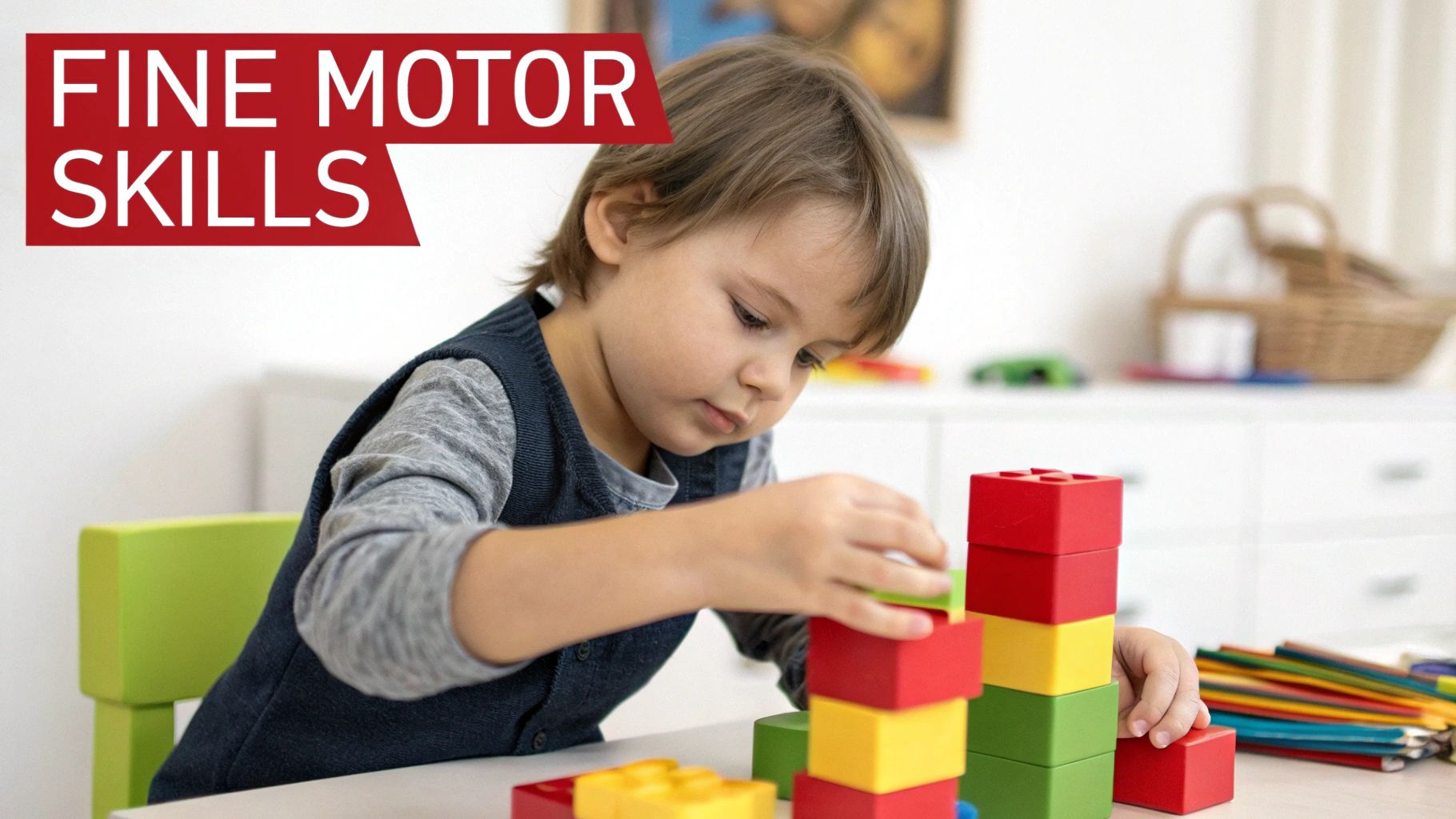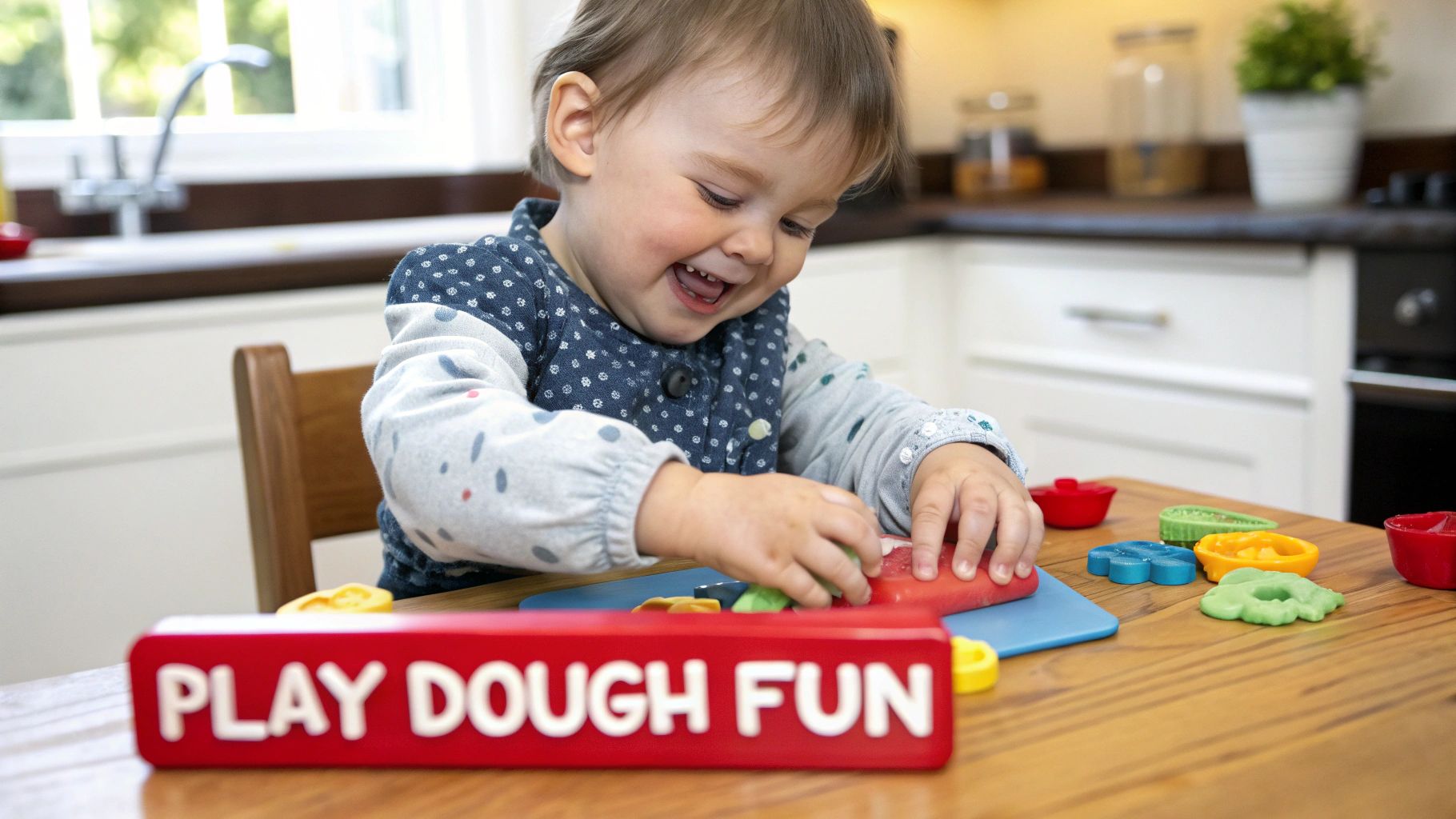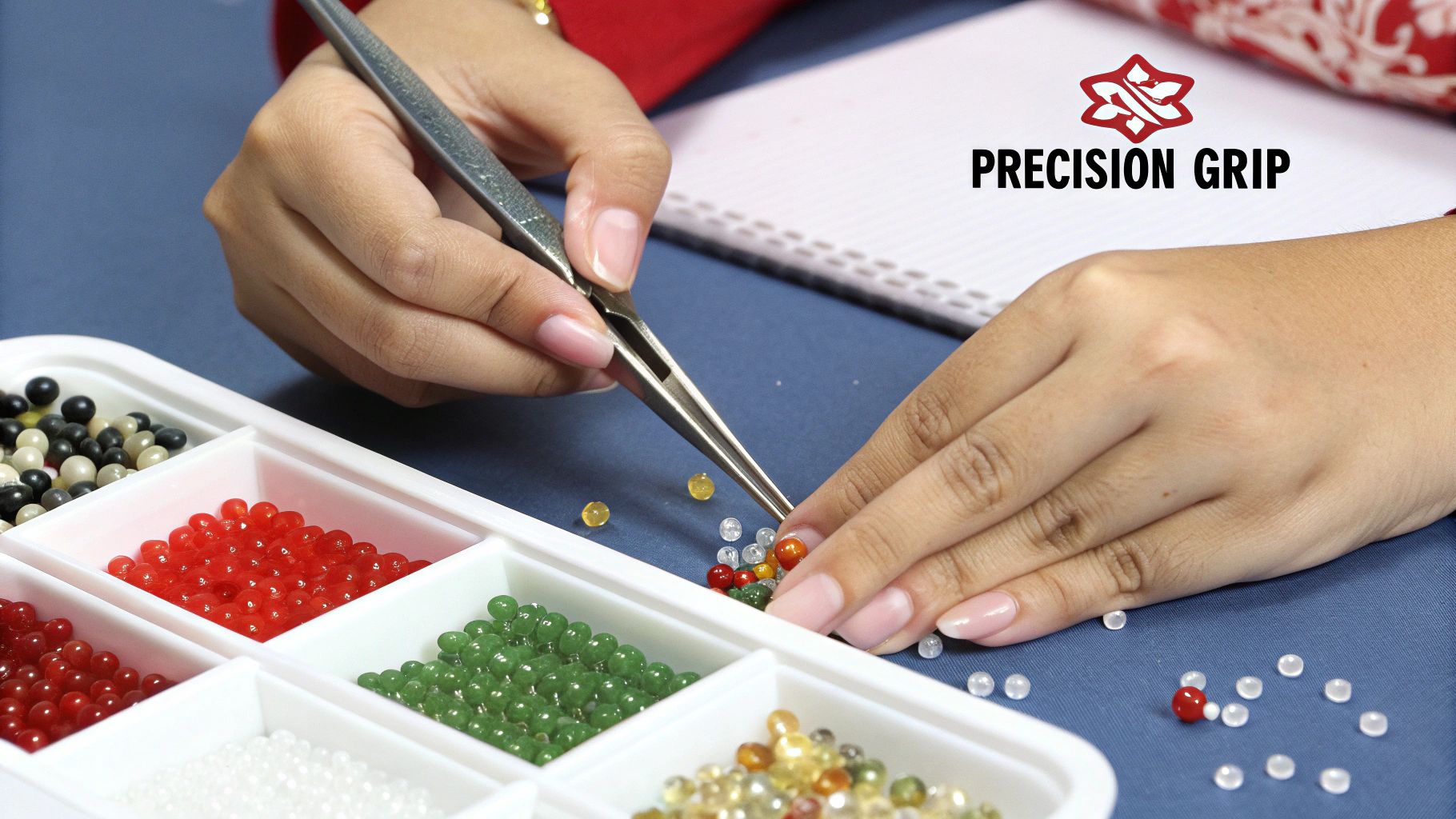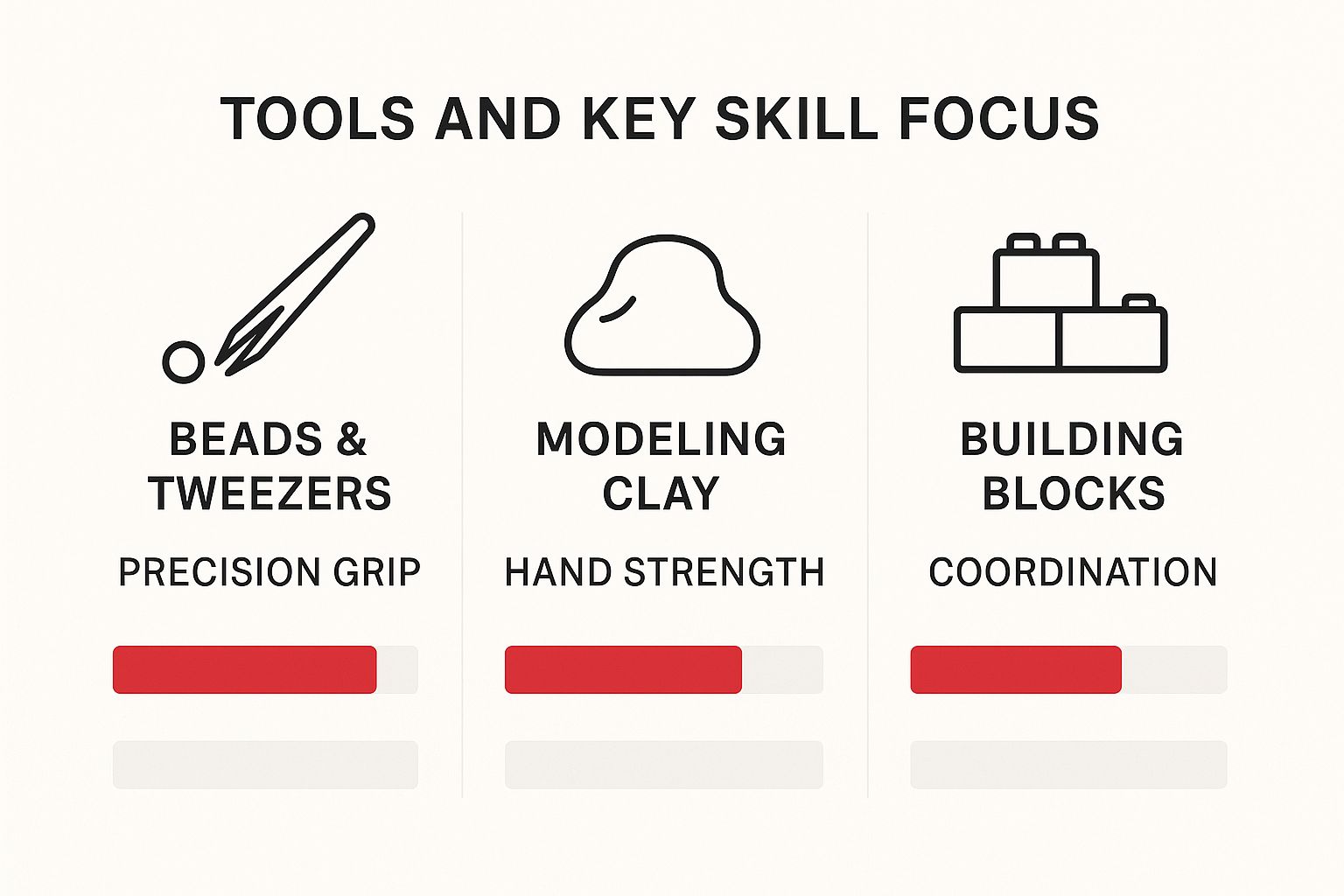
How to Improve Fine Motor Skills: Fun, Practical Activities for Kids
Improving fine motor skills is all about getting children involved in playful, hands-on activities that strengthen those tiny muscles in their hands and fingers. You can do this with simple, everyday fun like stacking blocks, squeezing modeling clay, or threading large beads. These aren't just games; they're the building blocks for essential life skills like writing, dressing, and eating independently.
What Are Fine Motor Skills and Why Do They Matter?

When we talk about fine motor skills, we’re referring to the coordination of small muscles in the hands, fingers, and wrists. These skills are far more than just a stepping stone to neat handwriting; they are the bedrock of a child’s independence.
Think about the detailed actions a child performs daily. Buttoning a coat, using a fork to spear a piece of fruit, or zipping up a backpack—all of these depend on solid fine motor control. Each action demands precise movements, hand-eye coordination, and dexterity.
The Building Blocks of Everyday Independence
Developing these abilities is a huge confidence booster for children. When a child masters a small physical challenge, like tying their own shoes, they gain a powerful sense of accomplishment that fuels their desire to tackle the next task. This foundation supports them in countless ways, both at school and at home.
The best part? The journey to improve fine motor skills is most effective when it feels like play. This is where the benefits of play-based learning really shine, turning skill development into a joyful, engaging experience.
From Core Skills to Real-World Actions
Let's break down how these foundational skills translate into a child's everyday life. This table clearly shows the connection between a specific motor skill and the practical tasks it enables.
| Core Skill | What It Looks Like | Everyday Task Example |
|---|---|---|
| Pincer Grasp | Using the thumb and index finger to pick up small items. | Picking up a single Cheerio or a small Lego brick. |
| Hand-Eye Coordination | The eyes and hands working together to perform a task. | Threading a bead onto a string or catching a small ball. |
| Bilateral Coordination | Using both hands together in a coordinated way. | Holding paper with one hand while cutting with scissors. |
| In-Hand Manipulation | Moving an object around within one hand. | Turning a pencil over to use the eraser. |
| Wrist Stability | Keeping the wrist steady to allow for precise finger movements. | Drawing a straight line or coloring within the lines. |
Seeing these connections makes it clear just how vital these foundational abilities are for a child's growing independence.
Key Takeaway: Fine motor skills aren't just about school readiness. They are fundamental life skills that empower children to become more independent, capable, and confident in their daily activities.
Why Intentional Play is So Effective
Purposeful activities designed to strengthen these muscles can make a massive difference. Research shows that targeted intervention programs are highly effective, with one meta-analysis finding that around 81% of such programs reported positive outcomes in fine motor skill development.
Interestingly, 78% of these successful programs were school-based, highlighting the importance of structured, playful practice. This data confirms a simple truth: intentional play works. When you understand the 'why' behind activities like squishing clay or picking up small objects, you can make playtime even more impactful. The rest of this guide is packed with practical, play-based ideas to help your child build this crucial foundation.
Turning Everyday Play Into Powerful Skill Building

You don’t need a room full of expensive, specialized toys to help your child improve their fine motor skills. In fact, some of the best developmental tools are probably already in your home.
The secret is to see simple items through a new lens—transforming regular playtime into an intentional, skill-building session. It’s about using what you have to target specific hand and finger movements. When a child squishes, rolls, and pinches modeling clay, they're not just making a colorful snake; they’re building crucial hand strength. When they click LEGO bricks together, they're getting a masterclass in hand-eye coordination.
Using Household Items as Skill-Building Tools
Look around your home, and you'll find a goldmine of opportunities. Everyday objects can be repurposed for fun challenges that wake up those small hand and finger muscles.
For a great practical example, give your child kitchen tongs and a bowl of cotton balls. Ask them to transfer the cotton balls into an empty ice cube tray. This simple game is brilliant for honing the pincer grasp and building hand endurance—the same movements needed for using scissors or holding a pencil.
Actionable Insight: This method of using familiar objects for new purposes is at the heart of effective skill development. It shows that learning can happen anywhere, turning routine moments into opportunities for growth.
How Classic Toys Build Specific Skills
Many classic toys are popular for a reason—they are fantastic for fine motor development. Here's a breakdown of how a few favorites target specific abilities:
- Threading and Lacing: Threading large pasta onto yarn or lacing beads onto a shoelace is perfect for practicing bilateral coordination (using both hands together). One hand holds the yarn steady while the other carefully guides the pasta or bead.
- Building Blocks: Stacking blocks demands precision, balance, and a controlled release. This strengthens wrist stability and teaches a child how to manage their grasp and placement—skills vital for writing and drawing.
- Stickers and Paper: The simple act of peeling a sticker off its backing is a top-tier workout for the pincer grasp. To add another challenge, draw small circles on paper and have your child place the sticker inside the target to refine their hand-eye coordination.
These examples are just the start. Once you begin to reframe play, you’ll see that learning isn’t separate from fun—it’s woven right into it.
For more structured ideas, check out our guide to play-based learning activities. It’s packed with more ways to make skill-building feel like just another great game.
How Gross Motor Skills Boost Fine Motor Control

It might seem counterintuitive, but big, whole-body movements are essential for developing small, precise hand movements. A child’s ability to meticulously hold a crayon is surprisingly connected to their ability to climb, swing, and crawl.
This is because gross motor skills—the large movements using arms, legs, and the torso—build the foundational strength and stability needed for fine motor precision. Think of the body as a pyramid. The large, strong muscles at the bottom (the core, back, and shoulders) must be solid before the smaller muscles at the top (the hands and fingers) can work effectively. Without that strong base, asking a child to perform a delicate task is like trying to write on a wobbly table.
Building Stability from the Core Outward
Control radiates from the center of the body outward. When a child develops strong core and shoulder muscles, they create the stability needed to control their arms. That control then travels down to the wrists, hands, and finally, the fingers.
For a real-world example, consider the monkey bars. When a child hangs and swings, they are giving their shoulder girdle and core an incredible workout. That’s the same stability that will later let them hold their arm steady while their fingers do the detailed work of buttoning a shirt.
Key Insight: Gross motor development is a prerequisite for fine motor success. Strong big muscles anchor the body, allowing small muscles to perform with precision and control.
Research from the NIH confirms this connection, showing that as physical activity boosts motor competence in children, they are more motivated to be active, creating a positive feedback loop.
Actionable Gross Motor Activities for Better Hand Control
Putting this into practice is simple: encourage big, energetic play that gets the whole body moving.
Here are a few powerhouse gross motor activities that directly support fine motor development:
- Climbing Playground Equipment: This builds upper body and core strength, crucial for stabilizing the arms and hands for tasks like using scissors.
- Crawling Through Tunnels: Animal walks and crawling strengthen the shoulders and help the two sides of the body learn to work together.
- Wheelbarrow Walks: This classic game is an amazing shoulder and core stabilizer. Hold your child’s legs while they walk forward on their hands.
- Swinging: Pumping on a swing is a sneaky core workout that also develops rhythm and timing, which translates to coordinated hand movements.
Even on a rainy day, there are plenty of ways to get those big muscles working. If you're stuck inside, check out our guide on the best indoor activities for kids for fresh ideas. By focusing on whole-body movement, you're giving your child the strong, stable base they need to master the delicate art of fine motor control.
Creating a Home Environment That Encourages Fine Motor Growth
You don’t need a home makeover to create a space that boosts your child's fine motor skills. It's about making small, intentional tweaks that invite your child to explore and practice naturally. The goal is to weave skill-building into the fabric of your daily life. When the environment is set up right, kids will naturally gravitate toward activities that strengthen their hands and fingers.
Setting Up Child-Friendly Activity Stations
An effective strategy is to set up simple "activity stations" in your main living areas. This doesn't need to be complicated—just a designated spot with a few appealing, ready-to-use materials.
For example, place a tray on a coffee table with a container of play-doh and a few cookie cutters. In another corner, a small basket with large beads and pipe cleaners works wonders. The key is accessibility. If the materials are out and easy to reach, your child is far more likely to engage with them unprompted.
Pro Tip: Rotate the materials in these stations every week or two. This simple swap keeps things feeling fresh and exciting, encouraging your child to revisit the stations and discover new challenges.
The Importance of Child-Sized Tools
Using tools and furniture that fit a child's body makes a huge difference. When a child can sit at a table with their feet flat on the floor and elbows resting comfortably, they have the core stability needed to make precise hand movements.
The same goes for their tools. Hand them child-safe scissors, chunky pencils, or small tongs that fit their grasp, and you'll see them build control and confidence. Asking them to use adult-sized tools can lead to frustration and awkward grip patterns. For ideas on tools that double as fantastic toys, look at our guide on the best learning toys for preschoolers.
This infographic breaks down how different common toys target specific fine motor skills.

As you can see, each material has a unique superpower—from building that delicate pincer grasp to developing overall hand strength. Thoughtfully placing these items in your home creates organic opportunities for skill-building.
Ideas for Fine Motor Activity Zones
| Zone | Materials to Include | Skills Targeted |
|---|---|---|
| Kitchen Corner | Kid-safe knives, small tongs, measuring spoons, dough for kneading. | Hand strength, pincer grasp, bilateral coordination. |
| Living Room Tray | Lacing beads, stacking blocks, puzzles with small knobs, modeling clay. | Precision, hand-eye coordination, problem-solving. |
| Art Easel / Desk | Chunky crayons, watercolor paints with small brushes, stickers. | Tripod grasp, wrist stability, finger isolation. |
| Outdoor "Dig Site" | Small trowels, buckets, spray bottles, small rocks or leaves. | Hand strength, dexterity, sensory exploration. |
Taking Skill Building Outside
Don't forget the backyard or local park—they are amazing fine motor gyms! Outdoor play is packed with opportunities to build hand strength and dexterity in a fun, sensory-rich setting. Digging in the dirt builds wrist strength, while picking up tiny pebbles or leaves is perfect for practicing the pincer grasp. Unstructured outdoor moments are just as valuable as any planned indoor activity.
Weaving Fine Motor Practice Into Your Daily Routine
For most busy families, adding one more thing to the daily schedule feels overwhelming. The good news is that you don't need to block out special time to work on fine motor skills. The best approach is to simply weave practice into the routines you're already doing.
By reframing everyday chores as opportunities for play, you create a low-pressure environment for consistent practice. This approach not only builds skills but also boosts your child's confidence and sense of contribution.
Why the Kitchen is the Perfect Practice Space
The kitchen is a fantastic place to start. Simple cooking and meal prep tasks are packed with chances to work on hand strength, coordination, and precision. Invite your child to be your little sous chef.
These small jobs are targeted exercises in disguise. Stirring thick batter builds wrist stability, pinching spices works the pincer grasp, and tearing lettuce leaves for a salad strengthens all the tiny muscles in their hands.
Actionable Insight: Shift your mindset. See getting dressed not as a race against the clock, but as a five-minute fine motor workout. This small change in perspective can turn a stressful morning into a valuable learning moment.
Turning Chores Into Skill-Building Challenges
Getting dressed, cleaning up, and even bath time can become powerful skill-building sessions. These daily routines are predictable and repetitive, making them perfect for mastering complex movements.
Here are a few practical examples of turning tasks into fine motor fun:
- Getting Dressed: This daily task is a goldmine for practice. Encourage your child to tackle buttons, pull up zippers, and fasten snaps. It might take a little extra time, but the payoff in their independence and dexterity is huge.
- Cleaning Up: Ask your child to pick up small toys one by one and place them in a bin. This simple action is great for that all-important pincer grasp. Wringing out a sponge or using a spray bottle also builds serious hand strength.
- Bath Time: Playing with squeeze toys, sponges, and droppers in the tub is a fantastic way to strengthen hand muscles while they're having a blast.
By folding these activities into your day, you’re laying the neurological groundwork for more complex tasks like writing. This hands-on approach is also a great alternative to passive screen time. For more tips, check out our guide on how to limit screen time.
Frequently Asked Questions About Fine Motor Skills
It's natural for questions to pop up as you watch your child grow. Every child develops on their own schedule, but understanding common concerns can provide peace of mind. Here are answers to some of the questions parents ask most often.
When should I be concerned about my child's fine motor development?
Remember that developmental charts are guides, not strict deadlines. Typically, the pincer grasp (using the thumb and forefinger) emerges around 9-12 months, and many children are ready to explore child-safe scissors by age three or four.
While every child's timeline is unique, a few gentle red flags might include a consistent struggle to self-feed, actively avoiding activities requiring hand coordination, or having a noticeably weaker grip than their peers. If you have concerns, a chat with your pediatrician or an occupational therapist is a great next step.
Key Takeaway: Early awareness is helpful, but patience is essential. Often, a child just needs more time and playful practice. Trust your intuition—if you feel something is off, seeking a professional opinion is always a good idea.
Do tablets and screens hurt fine motor development?
The key is balance. The main issue with excessive passive screen time is what it replaces: the hands-on, physical play crucial for building muscle and dexterity. A child can't get the same sensory feedback from a flat screen as they can from gripping a crayon, squishing play-doh, or stacking blocks.
However, not all screen time is detrimental. Interactive apps involving tapping, dragging, or tracing can support hand-eye coordination. The best approach is to view digital play as a supplement, not a substitute, for real-world activities that strengthen essential hand muscles.
What if my child dislikes arts and crafts?
If arts and crafts make your child run for the hills, don't worry! The goal is to practice the movements, not to create a masterpiece. There are plenty of non-crafty ways to work on fine motor skills that might be a better fit.
Try these real-world examples:
- Building Toys: LEGOs, magnetic tiles, and other construction toys are powerhouses for developing grip strength and precision.
- Sensory Bins: Fill a container with sand, water, or dry beans. Add scoops and small toys for pouring, digging, and pinching.
- Helpful "Jobs": Arm them with a spray bottle to "paint" the sidewalk—it’s amazing for hand strengthening. Or have them help in the garden by picking small weeds.
How can I best support my left-handed child?
Supporting a lefty is about making small environmental tweaks. A world designed for right-handers can be frustrating.
To make things smoother, teach them to tilt their paper slightly to the right when they write; this helps them see their work without hooking their wrist. A pair of true left-handed scissors can also be a game-changer. Finally, check the lighting: positioning it to come from the right prevents their hand from casting a shadow on their work.
At Playz, we believe that powerful learning happens when kids are having fun. Our science kits, building toys, and creative playsets are designed to make skill-building feel like an adventure. Discover how kids learn best through play at Playz and find the perfect tools to spark curiosity and strengthen skills, one experiment at a time.
